Amazon announced on its earnings call last Thursday that it plans to raise the price of its Amazon Prime service by between $20 and $40, or 25-50%, in the near future. The reason given was that the service launched back in February 2005 at $79, and the price hasn’t risen since, despite rising transportation and fuel costs. But I’m skeptical of that reasoning and I suspect the price hike is really about all the free stuff Amazon gives away with Prime beyond free shipping. Below, I’ll explain why.
Trends in shipping costs
Much of Amazon’s business is a black box – we have no idea how many Prime subscribers it has, how many Kindles it sells, what it makes from or charges for digital vs. physical media and so on. But shipping is actually one of the few things Amazon is pretty transparent about: each quarter, it reports total shipping costs, total shipping revenues (including some of its revenues from Prime), and the difference between the two. As such, we can calculate what percentage of Amazon’s total shipping costs were covered by shipping revenues, as shown below:
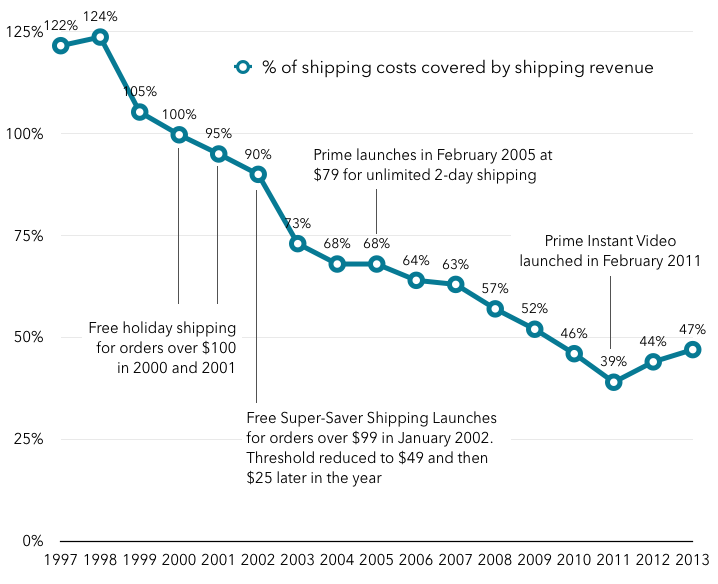 In its early history, Amazon made a profit on shipping – just over 20% in 1997 and 1998. But it soon realized that discounting shipping (a) removed one of the biggest competitive disadvantages it suffered against brick and mortar retails and (b) therefore was a very cost-effective form of marketing. Interestingly, over time, the net cost of shipping has come to very closely mirror actual marketing spend, even though it is not reported as such:
In its early history, Amazon made a profit on shipping – just over 20% in 1997 and 1998. But it soon realized that discounting shipping (a) removed one of the biggest competitive disadvantages it suffered against brick and mortar retails and (b) therefore was a very cost-effective form of marketing. Interestingly, over time, the net cost of shipping has come to very closely mirror actual marketing spend, even though it is not reported as such:
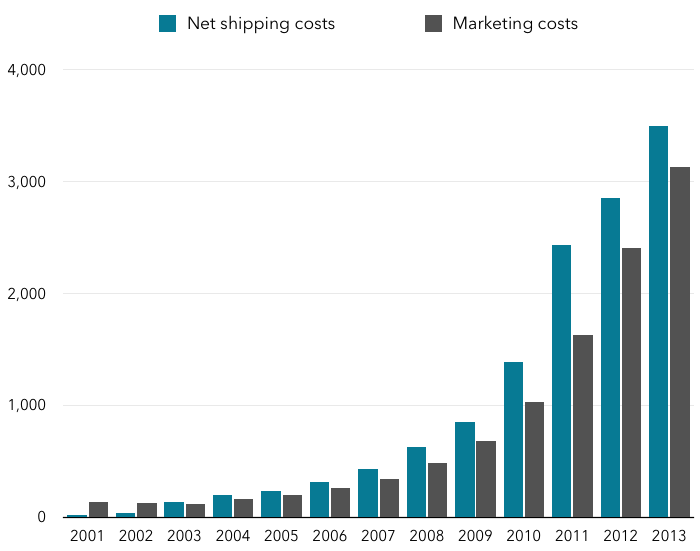 Put another way, Amazon spends roughly half its marketing budget on traditional forms of marketing, and the other half on discounted shipping, principally free super-saver shipping and Prime. By the time Prime launched in 2005, only about two thirds of shipping costs were paid by customers, and following the launch of Prime, the proportion paid for directly by customers had dropped to around 40%. During this time, shipping costs as a percentage of revenues actually fell through 2009, though net shipping costs rose through 2011:
Put another way, Amazon spends roughly half its marketing budget on traditional forms of marketing, and the other half on discounted shipping, principally free super-saver shipping and Prime. By the time Prime launched in 2005, only about two thirds of shipping costs were paid by customers, and following the launch of Prime, the proportion paid for directly by customers had dropped to around 40%. During this time, shipping costs as a percentage of revenues actually fell through 2009, though net shipping costs rose through 2011:
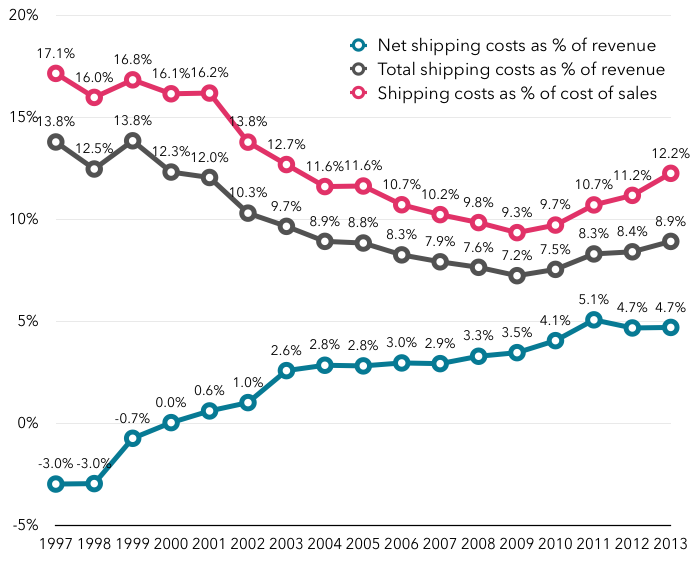 Fuel costs haven’t risen for the last three years
Fuel costs haven’t risen for the last three years
Interestingly, though, none of these lines closely mirrors what happened with fuel costs during this period. For a view of long-term fuel costs we can easily look at two major businesses which are closely tied to Amazon’s: FedEx and UPS. Their fuel costs as a percentage of overall expenses are shown in the chart below:
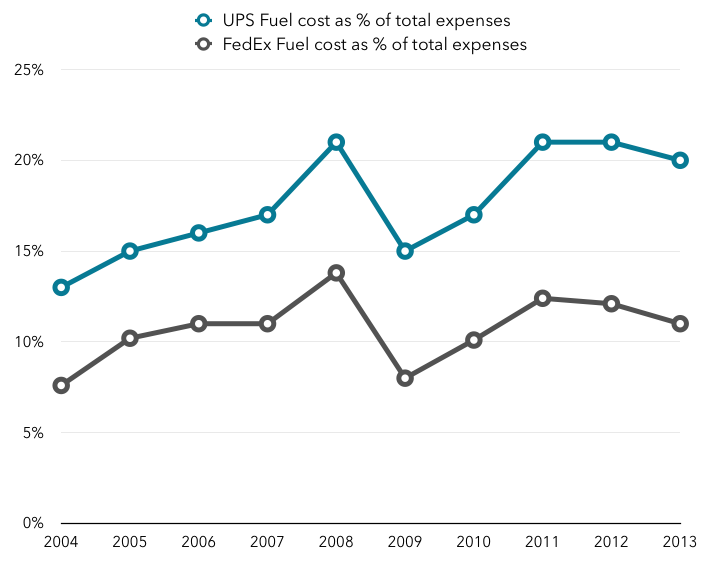 These fuel costs were heavily affected by overall gas prices, which rose steadily until summer 2008, and then dropped significantly over the following months as the financial crisis kicked in, then rose again before plateauing and even dropping slightly in the last couple of years. As a percentage of total costs, fuel costs are similar today to what they were in 2008 for these two companies. As such, almost all the increase in fuel costs happened in the early years of Prime, making an argument for raising the price of Prime based now on fuel costs spurious at best.
These fuel costs were heavily affected by overall gas prices, which rose steadily until summer 2008, and then dropped significantly over the following months as the financial crisis kicked in, then rose again before plateauing and even dropping slightly in the last couple of years. As a percentage of total costs, fuel costs are similar today to what they were in 2008 for these two companies. As such, almost all the increase in fuel costs happened in the early years of Prime, making an argument for raising the price of Prime based now on fuel costs spurious at best.
Giving away Instant Video is the real problem
So what has happened that makes Prime less cost-effective today than it was? The answer is all the content that Amazon has added to the Prime subscription, starting in 2011 with Prime Instant Video and the Kindle Lending Library. We’re back in black box territory here, but that there is a business that looks a lot like Prime Instant Video in the form of Netflix’s US streaming business. It has over 30 million subscribers, whereas Prime likely has about 50% fewer, and possibly even slightly less in the US, but these businesses should have fairly similar costs. Since Netflix is a public company, and explicitly breaks out its US streaming business, we have a decent proxy for Prime Instant Video. The scale of the business is roughly similar, and the selection of content is also fairly similar, so the economics ought also to be comparable. Below is a chart showing Netflix’s number of paid US streaming subscribers against its cost of revenue per subscriber, which is essentially the cost of acquiring and delivering streaming video to those subscribers:
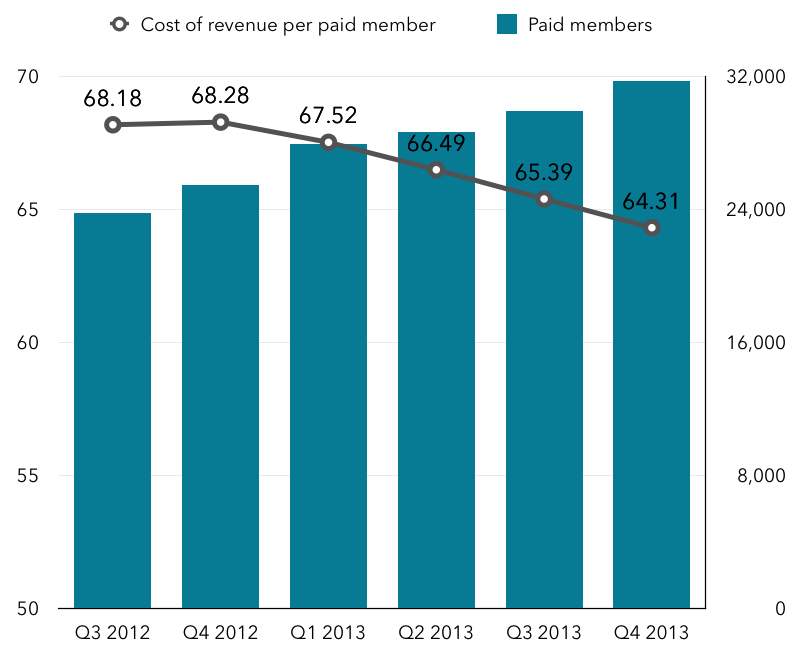 The cost of revenue per subscriber is dropping slightly, but it’s remained in the $64-69 range even as subscriber numbers have risen from just under 24 million to almost 32 million. As such, it’s likely that any business in the range of 10-20 million subscribers with a similar catalog of content would have a cost per subscriber in the $60-80 per year range.
The cost of revenue per subscriber is dropping slightly, but it’s remained in the $64-69 range even as subscriber numbers have risen from just under 24 million to almost 32 million. As such, it’s likely that any business in the range of 10-20 million subscribers with a similar catalog of content would have a cost per subscriber in the $60-80 per year range.
How does this affect the economics of Prime? Firstly, the annual cost of providing Prime Instant Video probably runs at somewhere around the annual price for a Prime membership. If unlimited streaming video were the only thing Prime members received for their $79, it would be a pretty good deal, and likely slightly profitable for Amazon. But of course, Amazon was already losing money on Prime shipping even before it added Instant Video to the proposition, as we saw above, so throwing in Instant Video just took it much further into the red.
But the second problem with Instant Video is that it breaks Amazon’s oft-stated principle of aligning customers’ interests with its own. As things stand, the more customers ship, and the more video they watch, the higher the costs for Amazon. As long as Prime only covered shipping, the cost could be seen as a marketing expense, because by definition every item shipped was an item sold, which generated profits elsewhere in the business. But every video watched purely incurs cost, while not stimulating any additional revenue-generating behavior at all. Adding Instant Video to Prime broke this positive relationship Amazon generally strives to maintain, and it – and not rising fuel and transportation costs – is the real problem with Prime.
The solution to the Prime problem
One way of looking at the problem is that Amazon simply made a mistake when it decided to bundle Instant Video into Prime for free back in 2011. The price of Prime was set almost at random from the beginning 1 so it’s almost a miracle that it worked as well as it did for so long. But the time for a price hike would have been early on in the history of Prime Instant Video, when the company started using video as a bribe to bring in customers who weren’t sold on free two-day shipping alone.
At this point, though, the solution is two-fold. First, split the current Prime service into two parts, shipping and instant video, selling each at $79 or possibly slightly less, but continuing to offer a bundle of both for the new price between $99 and $119. Secondly, offer monthly payment options, at least for the streaming service, to reduce the barrier to entry. Regardless, many of Amazon’s Prime subscribers will balk at paying an increased fee for the service, and even if they pay they’ll grumble. And the number who only use either shipping or streaming is relatively small. Most people I’ve spoken to over the last few days who use Prime bought it for the shipping and saw video as a bonus. CIRP’s research suggests 81% of Prime members use the streaming video service, so disentangling it wouldn’t be straightforward.
Ultimately, Amazon’s Prime problem is a cautionary tale about taking cross-subsidization too far. Cross-subsidization has been a mainstay of successful consumer technology companies for years: Apple has used its hardware to cross-subsidize software, Google uses advertising to cross-subsidize Android and other products, carriers use service revenue to subsidize devices, and so on. Amazon started by subsidizing shipping, and added subsidized 3G wireless connectivity with the Kindle, but may simply have gone too far with Instant Video. Cross-subsidization clearly works in this business, but this is a warning that it works best with internal rather than external costs, and pricing the core offering is key. If you price it too low, it’s awfully hard to go up later, as Amazon is about to find out.
Notes:
- There are several interesting insights into the debut of Prime, including the pricing of Prime, in Brad Stone’s book The Everything Store: “Selecting the fee for the service was a challenge; there were no clear financial models because no one knew how many customers would join or how joining would affect their purchasing habits. The group considered several prices, including $ 49 and $ 99. Bezos decided on $ 79 per year, saying it needed to be large enough to matter to consumers but small enough that they would be willing to try it out. “It was never about the seventy-nine dollars. It was really about changing people’s mentality so they wouldn’t shop anywhere else,” says [Vijay] Ravindran [then head of Amazon’s ordering systems]… In many ways, the introduction of Amazon Prime was an act of faith. The company had little concrete idea how the program would affect orders or customers’ likelihood to shop in other categories beyond media. If each expedited shipment cost the company $8, and if a shipping-club member placed twenty orders a year, it would cost the company $160 in shipping, far above the $79 fee. The service was expensive to run, and there was no clear way to break even. “We made this decision even though every single financial analysis said we were completely crazy to give two-day shipping for free,” says Diego Piacentini [Senior Vice President, Worldwide Retail and Marketing]” ↩
Pingback: Thoughts on Amazon earnings for Q1 2014 | Beyond Devices()